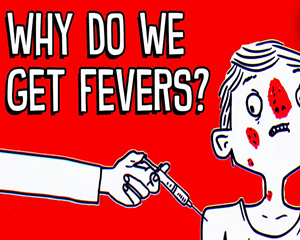(单词翻译:单击)
In 1917, doctors proposed an outlandish treatment for syphilis, the incurable bacterial infection that had ravaged Europe for centuries.
1917年,医生提出了一种治疗梅毒的奇特方法,当时,这种无法治愈的细菌感染曾经在欧洲肆掠了好几个世纪。
Step 1: Infect patients suffering from the later stages of syphilis with the parasite that causes malaria, the deadly but curable mosquito-borne disease.
第一步:使晚期梅毒患者感染一种能引起疟疾的寄生虫,疟疾虽然致命,但却是一种能被治愈的,以蚊虫为媒介的疾病。
Step 2: Hope that malarial fevers clear the syphilis. And step 3: Administer quinine to curb the malaria.
第二步:希望疟疾引起的发热能够清除梅毒。第三步:服用奎宁来控制疟疾。
If all went according to plan, their patient would be left alive and free of both diseases.
如果一切都按照计划顺利进行,那么病人的两种病都会被治愈。
This killed some 15% of patients, but for those who survived, it seemed to work.
有15%的病人死于这种治疗方法,但是对于其他活下来的病人来说,这种治疗看起来是有效的。
It actually became the standard treatment for syphilis until penicillin was widely used decades later. And its driving force was fever.
在接下来的几十年,青霉素被广泛使用之前,这一直都是治疗梅毒的标准方法。推动产生这个方法的动力就是发烧。
There are many mysteries around fever, but what we do know is that all mammals, some birds and even a few invertebrate and plant species feel fever's heat.
关于发烧有很多谜团,我们知道的是所有哺乳动物,某些鸟类,甚至一些无脊椎动物都能感受到发热。
It has persisted for over 600 million years of evolution. But it has a significant cost.
发热已经经历了超过6亿年的进化。但是发热也伴随着高昂的代价。
For every 1 degree Celsius of temperature increase in the human body,
人体温度每升高1摄氏度,
there's a 12.5 percent increase in energy required, the equivalent of about 20 minutes of jogging for some. So, why and how does your body produce a fever?
将会增加12.5%的能量消耗,相当于慢跑大约20分钟。那么,为什么你的身体会发烧?又是如何发烧的呢?
Your core temperature is maintained via thermoregulation, a set of processes that usually keep you around 37 degrees Celsius.
你的核心体温是通过体温调节维持的,体温调节是一系列让你的体温保持在37摄氏度的进程。
These mechanisms are controlled by the brain's hypothalamus, which detects minute temperature shifts and sends signals throughout the body accordingly.
这套机制通过大脑的下丘脑控制,下丘脑可以检测微小的温度变化,并通过变化向身体发送信号。
If you're too hot, the hypothalamus produces signals that activate your sweat glands or make your blood vessels dilate,
如果你的体温太高了,下丘脑会产生激活汗腺的信号,或者使你的血管扩张,
moving blood closer to the skin's surface -- all of which releases heat and cools you off.
让血液更接近皮肤表面,这些都会释放掉多余的热量,以降低你的体温。
And if you're too cold, your blood vessels will constrict and you may start to shiver, which generates heat.
如果你的体温太低,血管就会收缩,你可能会开始发抖,这又会使你的身体产生热量。
Your body will disrupt its usual temperature equilibrium to induce a fever, which sets in above 38 degrees Celsius.
你的身体会打破正常的体温平衡来引起发烧,体温会达到38摄氏度以上。
Meanwhile, it has mechanisms in place to prevent it from exceeding 41 degrees Celsius, when organ damage could occur.
同时,身体也有一套机制来防止体温超过41摄氏度,在这个温度下,器官将会受到损害。

Immune cells that are fighting an infection can induce a fever by triggering a biochemical cascade that ultimately instructs your hypothalamus to increase your baseline temperature.
而与感染作斗争的免疫细胞,将会通过触发一系列生物化学反应来引发发烧,最终指示下丘脑提高你的基准体温。
Your body then gets to work to meet its new "set point" using the mechanisms it would to generate heat when cold.
然后你的身体就会在这个机制下运作,以达到新的“温度设定值”,并在感觉冷的时候产生热量。
Until it reaches this new temperature, you'll feel comparatively cool, which is why you might experience chills. But why does your body do this?
在身体达到一个新温度的时候,你又会觉得比较冷,这就是你会打寒颤的原因。但是你的身体又为什么会有这样的生理反应呢?
While the jury's still out on how higher temperatures directly affect pathogens, it seems that fever's main effect is in rapidly inducing a whole-body immune response.
虽然关于较高的体温如何直接影响病原体还没有定论,但似乎发烧的主要影响是,它会迅速引起全身的免疫反应。
Upon exposure to raised internal temperatures, some of your cells release heat shock proteins, or HSPs, a family of molecules produced in response to stressful conditions.
暴露于较高的体温下,你的一些细胞会释放热休克蛋白,也就是HSPs,这是一类在高压条件下产生的分子。
These proteins aid lymphocytes, one of several kinds of white blood cells that fight pathogens, to travel more rapidly to infection sites.
HSPs帮助淋巴细胞更快地到达感染部位,而淋巴细胞是几种对抗病原体的白细胞之一。
HSPs do this by enhancing the "stickiness" of lymphocytes, enabling them to adhere to and squeeze through blood vessel walls so they can reach the areas where infection is raging.
HSPs通过增强淋巴细胞的黏性来达到这一目的,使它们能够粘附并通过血管壁,到达传染病肆虐的部位。
In the case of viral infections, HSPs help tell nearby cells to dampen their protein production, which limits their ability to replicate.
在病毒感染的情况下,HSPs的作用是抑制周围细胞自身蛋白质的产生,以限制它们的复制能力。
This stunts the virus's spread because they depend on their host's replicative machinery to reproduce.
这就阻碍了病毒的传播,因为病毒依赖于宿主的复制机制来繁殖。
It also protects surrounding cells from damage since some viruses spread by rupturing their host cells,
它还能保护周围的细胞免受伤害,因为一些病毒通过破坏宿主的细胞来传播,
which can lead to large-scale destruction, the build-up of detritus, and potentially even organ damage.
会产生大规模的破坏,比如碎屑的堆积,甚至可能造成器官的损伤。
The ability of HSPs to protect host cells and enhance immune activity can limit the pathogen's path of destruction inside of the body.
HSPs保护宿主细胞和增强免疫活性的能力可以限制病原体在人体内造成的破坏。
But for all we know about fever's role in immune activation, some clinical trials have shown that fever suppressor drugs don't worsen symptoms or recovery rates.
但就我们目前所了解到了的关于发烧在免疫激活中的作用,一些临床试验已经表明,抑制发烧的药物并不会恶化症状或降低痊愈的概率。
This is why there's no definitive rule on whether to suppress a fever or let it ride. Doctors decide on a case-by-case basis.
这就是为什么在控制发烧还是任其发展方面,始终没有明确的规定。医生可以根据具体情况做出决定。
The fever's duration and intensity, as well as their patient's immune status, comfort level, and age will all play a role in their choice of treatments.
发烧的持续时间和强度,以及病人的免疫状况、舒适度和年龄都将影响他们对治疗方法的选择。
And if they do let a fever ride, they'll likely prescribe rest and plenty of fluids to prevent dehydration while the body wages its heated battle.
就算他们真的不去控制发烧,也会建议病人充分休息和补充水分,以防止身体在对抗发烧的过程中脱水。


